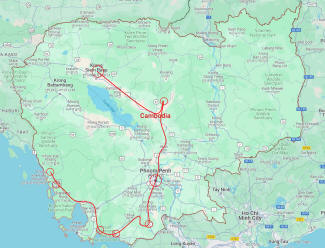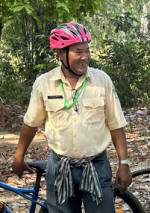
The basics: We flew through Dublin on the way to Cambodia, stopping for a day to visit with Brie, Aidan, and Little Dave. From there, we flew through Doha and ended up in Phnom Penh. We spent two weeks doing the smorgasbord tour, a little of everything Cambodia has to offer, using a “white glove” service, GeoEx. All of that was by car, with a driver and a guide (although we switched cars and guides when we hit Siem Reap), around 500 miles in total. We flew out of Siem Reap at the end.
 |
 |
There’s a lot to say about Cambodia, but if I was going to boil it down to two bullet points, it would be:
- Angkor Wat is indeed a bucket list item, and you should go there before
you die, and by Angkor Wat I really mean the entire Los Angeles sized temple and
city complex build at the height of the Angkor Empire, of which Angkor Wat is one small piece
- Cambodia itself is a country that is reeling from a knockout punch thrown more than twenty years ago by the Khmer Rouge, and it sheds a new light on the old, thorny “haves verses have-nots” issue, namely that getting rid of the “haves” is not a solution. For those that, like me, had a vague sense that “the killing fields” was some kind of purging of a portion of the Cambodia population, I’ll just go ahead and say that numbers-wise, it wasn’t quite the holocaust, but in some ways, I’d say it was worse. It didn’t target an ethnic group or a religion, it targeted the “elites” … artists, teachers, engineers, business leaders, anyone with a college degree. It crushed the entire population of Cambodia for a generation, and they are still trying to crawl out of that hole.
There are details in the following sections, which are presented here so you can skip all the stuff you have no interest in, which is probably everything other than the first couple:
- Phmon Penh, including the royal palace, the National Museum, eating
bugs, and the Genocide Museum
- Siem Reap and the Los Angeles sized temple complexes that surround it
(including Angkor Wat)
- The very
awesome Angkor National Museum
- Ireland and Little Dave
- The Nature Camp parts of the trip
- The Canvas and Orchid floating tent retreat and the Tatai river
- The Cardamom
Tented Camp and the Preak Tachan river
- All sorts of
weird critters and birds including the
cool Pearaing Biodiversity Center visit
- Bits that don’t fit into the above
- The Giant African
Pouch Rat and how we came to love it
- Pagodas
- Phnom Chhnork, a cave complex
- La Plantation, where we learned about growing pepper
- Kampong Trach and Wat Kirsan / Phnom Sor, a cave with a pre-Angkor temple in it
- The seafood market in Kep
- Bokor mountain with the black cathedral, the very weird Le Bokor Palace Hotel, and Wat Sampov Pram and its associated 100-year-old Pagoda
- The Giant African
Pouch Rat and how we came to love it
- A higher res map and some details about traveling
- The places we stayed, including the completely awesome Rosewood Hotel, the Amber Kampot Resort, and the also very awesome PhumBeign, a Disneyesque resort that tries to emulate an idyllic local village complete with rice paddies and water buffalo.
- GeoEx, our white glove service, which gets four out of five stars (which is not good)
And, finally, here are a few culturally inappropriate observations about Cambodia:
- The word for
“yes” in Khmer (the official Cambodian language) is different for men and women, but the word for “no” is the same.
- One third of the population have
itty-bitty spirit houses outside and they leave offerings of water,
coffee, bubble gum, and other fanciful items for the fairies.
-
There are a lot of monks that live in ornate temple-like buildings call
Pagodas. They dress in orange robes. You can make offerings
of dried fruit and ginger-ale, and then they douse you with water and
flower petals, meaning you are blessed for exactly three days. This is
indicated by a red string you tie around your wrist.
- An average white collar worker (like a teacher or a administrator) in
Phnom Penh makes around $250 US a month; an established street food
vendor with a ten foot by ten foot stall makes around $1000 US a month.
- There are almost no traffic
signals in the big cities, and eighty percent of the traffic are small
mopeds and three wheeled tuk-tuks. Add that to a complete lack of
right of way rules or semblance of road signs, and the traffic patterns
are best described as chaotic, except during rush hour, when they become
chaotic evil.
- In south-western
Cambodia (around Phnom Penh), we travelled extensively on the main
roads, and about half of them were under construction, by which I mean
“missing.” As a result, the maximum speed limit most of the time
was about 20 KPH, about as fast as a human can run. (To be fair,
there was actually a fair bit of construction going on)
- In the words of Trump, “China-China-China.” There were Chinese
everywhere. Chinese schools, Chinese businesses, Chinese shops.
The road construction is financed by China. So is the new (very
modern, very empty) Siem Reap International Airport. For one and a
half percent of the population, them seemed very over-represented.
It feels like Cambodia is becoming a Chinese vassal state.
- And China-China-China. They eat a lot of weird stuff in China, and Cambodia is happy to provide it. From sea leeches, one of the most vile and revolting creatures on the planet, to bird spit. There are dozens of huge multi-story buildings around the country with narrow, screened in windows that are dedicated to birds whose spit is used to make nests, and those nests are in turn turned into Chinese bird’s nest soup. I’d say the bird spit is worth it’s weight in gold, but that would be wrong. At $100 for a half ounce, it’s about twice it’s weight in gold.
|
And one plug for anyone thinking of going
to Siem Reap; our guide, Pum Roath (aka “Rod”) was fantastic and
if are thinking of going to visit the temples, I’ll send you his
contact information. |
 |